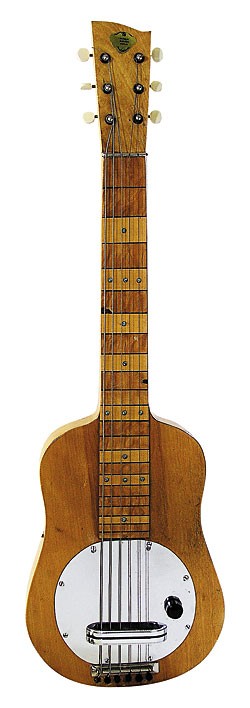
Hanburt “Style 1” in maple. Photo by Julie Woods.
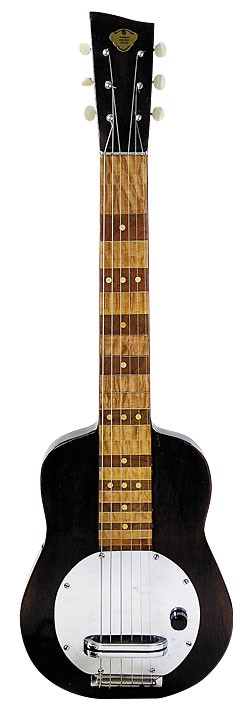
Black walnut “Style 1”. Photo by Julie Woods.
As a brand of American electric instruments, the name “Hanburt” is about the furthest thing from being a household term. Nevertheless, the recently documented saga behind this obscure line of electric guitars that originated just prior to World War II offers a rather interesting story.
As a matter of fact, until recently, nobody – not guitar collectors, history buffs, or museum specialists – was even aware of their existence. Nobody, that is, except guitar historian Lynn Wheelwright, who is always finely tuned to mysterious rumblings in the realm of rare guitars.
The mystery arose a few years ago, when Wheelwright acquired a Hanburt lap steel from Portland, and it bore striking similarities to 1930s Audiovox guitars, which were made in Seattle. Knowing that I have devoted a lot of effort to tracking down and documenting the story behind that overlooked line of pioneering electric guitars, he suggested I keep my eyes peeled for clues that might prove a connection between the two long-gone companies.
While perfectly open to discovering any such evidence, I had no idea where it might ever surface. Such is the way these quests unfold that a crucial piece of the puzzle can arise most anywhere – and this time that occurred when my wife and I were out shopping at Hansen Lamp and Shade shop in Seattle’s Phinney Ridge neighborhood. While she looked over the offerings, I poked around listlessly until my gaze settled upon an old photograph on the wall – a torn, wrinkled, black-and-white image of a retail display of a few electric instruments highlighted by a cloth banner that read “Hanburt Electric Instruments.”
I was stunned to learn that the shop’s long-deceased namesake founder, Harvey Hansen, had made and marketed his own line of instruments. Unfortunately, that’s about all the sales clerk knew and so I moved on, thinking I would revisit the matter when time permitted.
Meanwhile, I continued my work as Senior Curator at Seattle’s Experience Music Project (EMP) developing, among other exhibits, their Quest for Volume: A History of the Electric Guitar display. In time, Wheelwright sent me images of his Hanburt and it finally sunk in that these instruments do indeed bear an uncanny resemblance to the Audiovox units. Now my interest in the mystery intensified and I set about tracking it down.
By interviewing two of Harvey Hansen’s sons, Harold and Gail, and conducting additional research I’ve been able to piece the following Hanburt Guitar company history together – a history that proves Wheelwright’s hunch to have been dead-on correct.
The Hansen Lamp and Shade shop was founded about six decades ago by a hard-working couple, Harvey and Emily Hansen. Harvey M. Hansen (1898 -1990) was born in South Dakota and by the 1920s had become a railroad fireman at Stevens Point, Wisconsin. In time he met and married Wisconsin native, Emily Mae Holburt (1901-1993). It was circa 1927 – and four years after the birth of their first son, Harold – that the young family jumped into their Model T and drove west to Seattle.
Upon their arrival the young family discovered that economic times were just as tough there as back home. Still, by ’28 the Hansens had settled into a rental home in Columbia City – an old neighborhood in the Rainier Valley area – and Hansen found employment at the Columbia Lumber Company. He worked as a lumberyard truck-driver and by 1929 they moved to their first home at 4220 Lucille Street.
Then, right around the time of the worst economic collapse in U. S. history – 1929’s Wall Street stock market crash (and subsequent Great Depression) – the Hansens were blessed with a second son, Forrest Henry (then a third in 1934, Gail), and the pressure to increase the household’s income mounted. Throughout those tough times, Hansen took on any temporary jobs he could find, including hustling to raise money by trying to sell items door-to-door.
“My dad… if he got anything, he’d go knock on doors and try to sell it – all over Seattle,” recalled Harold, “He’d peddle.”
The times were lean and he was handy – usually made whatever he needed: “He used to make everything,” concurred brother Gail. “He made everything by hand. He was a tinkerer. Anything he ever needed, he just made.” “He was handy,” said Harold, “he was uneducated, but very, very clever.”
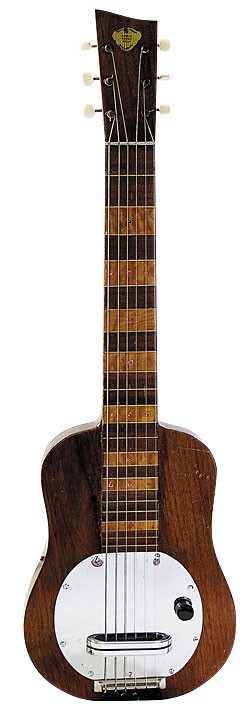
Natural walnut “Style 1”. Photo by Julie Woods.
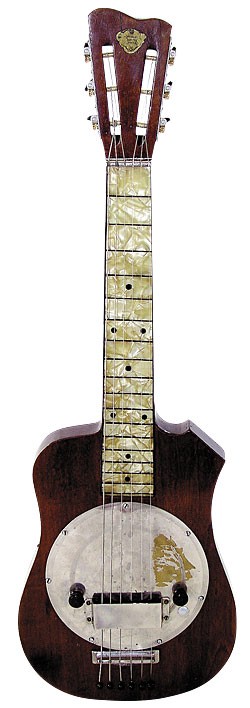
Hanburt “Style 2” in walnut. Photo by Julie Woods.
Among the things Hansen created for door-to-door sales were flower vases, figurines, electric lamps, and eventually, with the help of his wife, stenciled and/or painted parchment (and then silk) lampshades. Meanwhile, the general economy – and the Hansens’ lamp and lampshade sales – were improving and the family began dreaming about opening its own retail shop.
That’s when “fate” intervened, as Harold recalled, in the form of a religious radio broadcast that featured the electric Hawaiian guitar playing of a local musician named Paul H. Tutmarc. By the mid ’30s Tutmarc was a prominent tutor whose school taught singing and guitar playing. He was also Seattle’s most prominent Hawaiian Steel guitarist. As early as 1930-’31, he had experimented with electrifying a hollowbody Spanish-style acoustic, and by ’35 he had (with the assistance of a couple other skilled craftsmen) launched Seattle’s Audiovox Manufacturing Company, which began marketing a line of electric guitars – including what was likely the world’s first electric bass guitar.
Then, in November of ’35 Tutmarc, a businessman who rarely turned down offers to perform given that he would simultaneously be promoting his instruments and music school, accepted an invitation to perform at the Hollywood Temple. The congregation’s warmth and approval of hearing various sacred hymns played on his newfangled electric Hawaiian Steel guitar brought Tutmarc back for Sunday performances several weekends in a row. And if the music inspired the audience – both in the church’s pews and across the region as those Sunday services were broadcast on Seattle’s very powerful KJR – the influence was a two-way street; in early December, Tutmarc and his family joined the church (which later was reorganized as the Calvary Temple).
But it was those KJR broadcasts that impacted the future of the Hansen family. Harvey and Emily were both absolutely taken by the sounds of Tutmarc’s guitar. It was the “siren song” that pulled them from their south-end home to visit the Hollywood Temple to see and hear for themselves. As a result, three things occurred: in 1937, the Hansen family moved north to the Green Lake neighborhood, became members of the Calvary Temple, and rented a commercially zoned shop with a residential apartment upstairs located at 6244 Woodlawn Avenue. By the following year, the Hansens had modified the building to include a workshop and the Hansen Lamp Shop store on the street level.
By this time, they’d also expanded to sell lamps and lampshades, and being a can-do fellow who never shied away from borrowing ideas and plunging ahead on his own, Hansen, according to Gail, “made all his lamps. He’d turn the wood on a lathe. He made all the parts for everything.” He also repaired electrical appliances including record players and organs.
And thus, Hansen, whose wife, Emily, had shown no musical inclinations but had became fond of the tones of Tutmarc’s instrument, committed to building her a guitar. And even though Hansen understood basic electrical wiring techniques from his lamp-making business, rigging an electromagnetic guitar pickup was somewhat trickier. According to Gail, once his father began trying to devise a workable pickup device, he realized he needed a bit of help. “Once in a while he’d get stuck on something, so he’d get a friend to help.”
In this instance, Hansen recruited Barney E. Egerer, an electrician and mechanic who worked for Countner’s Record and Phonograph Co., which sold and serviced “automatic phonographs,” nickelodeons, pinball machines, and other items in its shop on Eastlake Avenue.
Egerer was, Harold recalled, “a genius who could do anything and [Harvey] told him ‘I’d like to make a guitar. And I’d like to make it electric.’ So they got together and figured all this stuff out.” How much experimentation the duo conducted is unclear – Harold remembered an early pickup device that, “He finally got to make a sound, then got to making a guitar for it. [But] he had trouble when he tightened the wires too tight and bent the guitar! He worked and worked on that.”
Whether or not that particular pickup was an all-new design or not remains unknown, but what is an apparent fact is that their quest was ultimately helped along when the ever-frugal Hansen finally bought an Audiovox guitar and amplifier in order to dissect their internal workings.
“Oh, my dad would take any ideas. He’d steal them,” Harold admitted. “He got hold of one of [Tutmarc’s] guitars and took it apart.” From there, it seems that Hansen and Egerer simply disassembled the instrument and figured out its mysteries one component at a time; Egerer “helped teach him how to make the coils that make the sounds. I think dad cut the steel or iron T-shaped [pickup blade component] things. And the two of them worked to get the sounds right.”
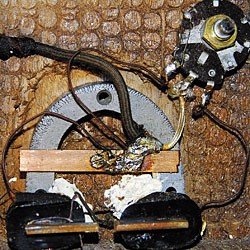
The Hanburt pickup.
Once they had the electrical components analyzed, the shape of the guitar was considered and Hansen moved forward with a body profile that is a near-identical knock-off of two Audiovox units: the Model #136 and the redesigned #436 Hawaiian Steel Guitars. Indeed, while Hansen did eventually add plenty of his own design flair to his guitars, the multiple similarities they share with Audiovox instruments are unavoidable. In fact, by the time he finished his first complete instrument (which still survives), it had taken on quite a few of the physical attributes of Audiovox instruments – which meant, of course, that his wife would love it!
Emily took to the instrument with natural ease, learning to play it so fast that she was soon hosting jam sessions with other folks at their Woodlawn apartment. “They did a lotta stuff at that place,” Harold fondly recalled. “They had a lotta fun. They used to get big jamborees goin’ in that lower part of the building and they’d have people over. My grandmother [Iola Eupheney Holburt], she was a tiny little thing, she’d come in and play the piano, and she could outplay anybody! She would get these professional up-to-date people and they’d play something and she didn’t even need the music. She beat that big upright old piano ’til it wiggled! So they had big jam sessions down in the basement there. But they played their guitar – it was always there, making noise. My mother got pretty good at it.” Indeed, Emily apparently became adept enough that before long she began taking on students herself. And so they reorganized their storefront by dedicating a portion of it to a music studio where Emily began offering Hawaiian steel guitar lessons to the public.
It was at this point that Hansen decided to establish his own commercial line of instruments under the brand name of Hanburt (which was simply a conflation of Hansen with Emily’s maiden name, Holburt) Electric Guitars. In addition, he also began building matching amplifiers (again based on Audiovox design specs) and hard-shell cases for the instruments. The intention, of course, was to produce guitars and amps they could sell to Emily’s students.
The 1941 R.L. Polk Business Directory is the first that shows Emily with her own listing as a “Music Teacher (guitar).” The ongoing augmentation of their business activities is reflected in the 1942 edition which features a listing under the “Musical Instruments Manufacture and Repair” category for Hansen, and the couple amended their main business listing to reflect this new side business. Now instead of just advertising that they retailed lamps and lampshades, they boasted: “Hansen Lamps and Musical Instruments.” “He’d make ’em and sell them to her students, and she’d teach electric Hawaiian guitar,” recalled Gail. “She had a number of students. It wasn’t a big thing but it was steady income.”
Indeed, the 1943 Polk directory amends Emily’s listing to “Music Teacher (Hawaiian guitar).”
Ultimately Hansen apparently marketed at least three different models of Hanburt electric Hawaiian lap steels. The first/earliest is like Emily’s – an essentially full-shouldered guitar-shaped body and 23-fret neck. The second (like those pictured in the photo of the vintage display) had a cutaway upper treble bout with a squared-off “horn” and 18-fret neck. The third had a stairstep body shaped much like a 1938 Art Deco-styled National New Yorker lap steel guitar.
The design aspects and components on the surviving units include commonalities as well as the occasional variance. They usually have an eye-popping fretboard surface comprised of alternating light (maple) and dark (walnut) wood veneer strips (although at least one was given a white pearloid fretboard). Other typical features include a metallic-gold Hanburt logo decal (with a rose flower graphic motif) on the peghead, a freefloating and chromed cast-metal bridge, and bakelite or ebony end pins rather than the era’s more typical (and practical) stop or floating trapeze tailpiece. Some have smooth faceplates, others are etched. “Style 1” guitars have charming kitchen-drawer-pull palm rests and inset faux (pink, blue, golden) glass “jewels” for fretboard markers, while “Style 2” have sheet-steel rests and more typical inlaid markers.
While some of these details are somewhat unique, Hanburt instruments evince considerable clues that Hansen had indeed borrowed a lot directly from the Audiovox guitars, including: a wooden body a parallel-to-the-bridge blade-style split-polepiece pickup with wired-in-series twin coils and a large below-the-strings horseshoe magnet; an asymmetrical wavy headstock; hardwired cloth-covered cord running out of the inside edge; “mirror-steel” faceplate; and metal nut and bridge.
Considered in total, one might think a proud businessman like Tutmarc would have been furious about Hansen’s copycatting. And, sure enough, he was.
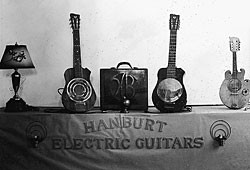
The Hanburt Electric Guitars display photo that hangs today on the wall at Hansen Lamp and Shade shop in Seattle.
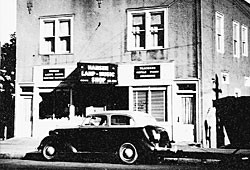
The Hansen Lamp and Music Shop. Lamp repair on one side, guitar instruction on the other.
“Paul [Tutmarc] senior was pretty upset for a while that dad had come in there and done that,” Harold admitted. “There was some friction between him and Paul. Dad would put a little gold leaf label on his guitars and somebody from… Paul would get hold of it [and] take my Dad’s sticker off and put his on (laughter)! That was part of the game!”
Even the good-natured namesake son of Tutmarc, the late Paul “Bud” Tutmarc, Jr., confirmed (when firmly prodded) that there indeed had been some tension between the two companies, but his father never bothered to pursue legal action against his fellow church member.
Meanwhile, in or about 1944 the Hansen’s landlord raised the rent and by ’45 they’d relocated westward, beyond Green Lake a few blocks. Buying their own mixed commercial/residentially zoned building, they opened the Hansen Lamp and Music Shop and erected twin exterior signs that announced, “Repair: Lamps Radios Electric Guitars” and “Teachers: Guitars Piano Accordion.”
“It was one of the oldest buildings on this avenue,” recalled Gail. “There was six units; one was a grocery store, one was somethin’ else. A couple of apartments up and a couple bachelor apartments in the basement. Our family lived where the store part is.” Gail also recalled that the main floor featured the lamp and shade retail area, and a separate music studio where Emily continued offering steel guitar lessons. “My mother used to teach Hawaiian electric guitar in the building. One side was the lamp store and the other side was the guitar studio.”
“My mother played the guitar,” added Harold. “But dad couldn’t play – he made a couple little noises. He wasn’t a musician. He was a mechanic and could do anything with his hands. Couldn’t read a book – but he could make anything.” Perhaps it was in the years after Harold left home that his father gained a bit more musical skill, because Gail recalled, “My dad made an organ and played it for years. He made harps and guitars and organs.” And as one of the Hanburt retail display photos reveals, Hansen also made at least one Hanburt electric mandolin, as well.
While the whereabouts of that mandolin remain unknown, in a similar fashion no one seems to have a clear grasp of the extent of Hansen’s guitar-building efforts. “He made guitars… and sold a lot of them,” said Harold. How many? Ten? A hundred?
“Oh, probably more than that,” Harold recalled. “He had them stacked around – a lot of them. I remember that he ran around [Washington state] showin’ it to people, and sold a lot of them.”
Perhaps so, but Gail (who lived at home long after Harold moved out), offers a quite different estimate – one that calculates that before Hansen stopped making them he’d produced a total of “Maybe 20 over the years. Then he got full-time into lampshades to make a livin’.” That estimate sounds about right to someone whose research has accounted for a total of 14 instruments (and three amps bearing the Hanburt brand).
Interestingly, the Hansen family still owns Emily’s guitar, and it’s paired with a vintage Audiovox amp. For her part, Emily carried on playing and teaching until at least her 70s, but Gail thought that Harvey wound down his instrument-making around 1950. By ’51, the business had expanded, adding a second shop that was to be run by Harvey’s brother, Hadley Hansen. But they had a falling out and Hadley returned to California within the year. Soon after, his shop was closed and sold.
Then, circa 1952, Harvey and Emily moved into a new home, where they spent their last years. Harvey took up still-life oil painting, and the two participated in lawn-bowling tournaments. In ’57, Harold opened his own business, Harold’s Lamps, in Seattle’s Wallingford neighborhood. Harvey retired in ’62, passing Hansen Lamp & Shade to Gail. In the mid ’80s Gail hired his own son, Jeff, to assist, and in ’95 he took over, just as Harold’s son, Kim, still carries the torch at their shop.
Although Harvey, Emily, and Harold Hansen are no longer with us, the story of the family’s Hanburt Guitars enterprise – once seemingly fated to be relegated to the status of lost history – has been unearthed.
Peter Blecha is the author of 1997’s Wired Wood: The Origins of the Electric Guitar, 1999’s Vintage Guitar feature, “Discovered: The World’s First Electric Bass!,” 2000’s Quest For Volume: Electric Guitars and the Auditory Arms Race, 2005’s Rock & Roll Archaeologist, and his latest, Music in Washington: Seattle & Beyond.
This article originally appeared in VG‘s June 2008 issue. All copyrights are by the author and Vintage Guitar magazine. Unauthorized replication or use is strictly prohibited.



